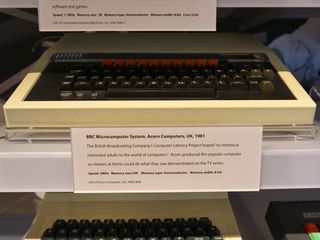Computer History: From The Antikythera Mechanism To The Modern Era
In this article, we shed light on the most important moments in computer history, acknowledging the people that have contributed to this evolution.
Intel 80386 And The Attack Of The Clone PCs - Acorn Archimedes
In 1985 Intel introduced its new CPU, the 32-bit 80386 or i386. The i386 was significantly faster than its predecessor, the 80286, and fully compatible with all existing applications, even the ones that were developed for the 8086 and 8088 processors. The i386's speed ranged from 12 MHz to 40 MHz. An i386 clocked at 33 MHz was able to perform 11.4 million instructions per second (MIPs) while a 80286 CPU clocked at 12 MHz could only perform 1.8 MIPs. As you can see, the difference is huge and this is why the i386 is a landmark in Intel's history.
To the great surprise of the computing community, the first PC equipped with an i386 didn't come from IBM, which was a leader in the PC market. Instead, the PC with the i386 chip was introduced by Compaq, which later merged with Hewlett-Packard. We should mention that Intel initially approached IBM, offering its new CPU, but the company refused; IBM wanted to keep using the older 80286 because it had manufacturing rights for the CPU. Ultimately, the Compaq i386 was a great success and made the PC clones (i.e. computers compatible with IBM PCs) highly popular.
Acorn Archimedes

In the mid-1980s an English computer manufacturer, Acorn Computers, decided to find a replacement for the aged 8-bit 6502 CPU that it used until that time. Acorn approached Intel in an effort to get the required rights to use the 80286 CPU, but the respponse was negative. This forced Acorn to build its own processor, and the final result was ARM (Acorn Risc Machine), which was a powerful RISC (Reduced Instruction Set Computing) type processor. RISC CPUs achieved higher performance than the CISC (Complex Instruction Set Computing) CPUs through the use of a smaller set of simple, but frequently-used commands.
The first Acorn computers with the new ARM CPU arrived in the summer of 1987 as the 300 and 400 series computers. A couple of years later, in May 1989, Acorn released a competitor to the Amiga 500 and Atari 520 ST: the Archimedes 3000 or A3000.
The A3000 computer was equipped with an ARM2 processor clocked at 8 MHz and had 1MB of RAM. The ARM2 CPU allowed the A3000 to perform 4 MIPS, which made it about seven times faster than the Amiga A500. The operating system, the RiscOS, featured a GUI and supported the parallel execution of multiple tasks (multitasking). RiscOS was stored in A3000's ROM along with a BBC BASIC V compiler and various other applications.
In addition, Archimedes was equipped with a 3 ½" floppy drive that supported disks with up to 800 KB of capacity. Thanks to its open architecture, the computer could also receive upgrades through expansion cards. Moreover, the A3000 was supported by many programming languages including C, Fortran 77, Pascal and LISP. One of its strong points was its advanced graphics capabilities; it supported 21 different resolutions.
MORE: Best Deals
Stay on the Cutting Edge
Join the experts who read Tom's Hardware for the inside track on enthusiast PC tech news — and have for over 25 years. We'll send breaking news and in-depth reviews of CPUs, GPUs, AI, maker hardware and more straight to your inbox.
MORE: Hot Bargains @PurchDeals
Current page: Intel 80386 And The Attack Of The Clone PCs - Acorn Archimedes
Prev Page Commodore Amiga Next Page NeXT CubeAris Mpitziopoulos is a Contributing Editor at Tom's Hardware US, covering PSUs.
Most Popular

